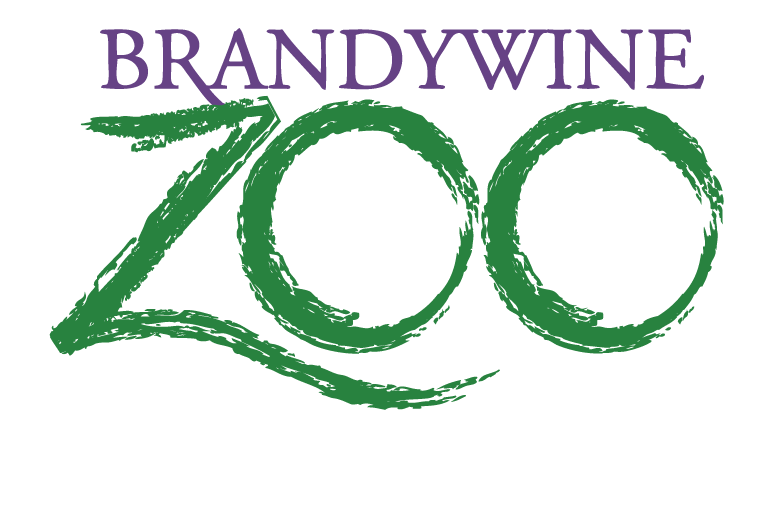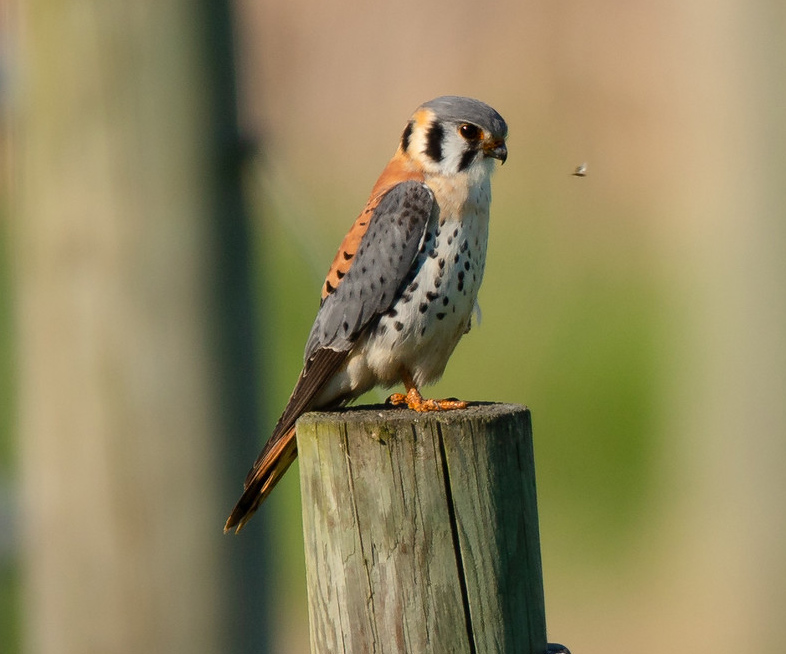Delaware Kestrel Partnership
Our Mission
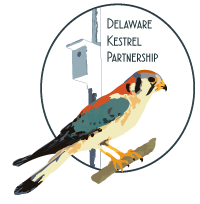 To determine probable cause of decline in Delaware’s American Kestrel populations by; conducting demographic studies which utilize the guidelines of the American Kestrel Partnership, unifying citizen and professional science data, and educating the general public on American Kestrels and ways to help increase their population.
To determine probable cause of decline in Delaware’s American Kestrel populations by; conducting demographic studies which utilize the guidelines of the American Kestrel Partnership, unifying citizen and professional science data, and educating the general public on American Kestrels and ways to help increase their population.
American Kestrel Monitoring
The smallest falcon in North America, the American Kestrel is listed as endangered on Delaware’s Endangered Species inventory. In the Mid-Atlantic region, its population has declined 88% since the 1970s (according to data from the USGS Breeding Bird Survey).
In 2014, The Brandywine Zoo began working with the American Kestrel Partnership, a project of The Peregrine Fund, a nonprofit organization promoting research and conservation of birds of prey worldwide. What started in an attempt to better understand kestrel populations in Delaware has now grown into a multi-organizational partnership across the state. In 2016, the Delaware Kestrel Partnership was formed so that all partners could share information and to streamline efforts.
Why Study Kestrels?
Only long-term monitoring can provide a reliable picture on population trends; while bird counts can validate that there are fewer breeding kestrels in the northeast, they do not provide definitive data that would advance kestrel demographics and influence conservation planning. As top predators of their food chain, raptors are an indicator species of the overall health of their ecosystems; observing habitat alterations will enable scientists to determine avenues to stabilize the population.
The Brandywine Zoo is helping to study Delaware’s fragile population of kestrels in order to better understand their needs in the state. Data collected from studies done by the Zoo will help to better understand how to protect kestrels around the country.
What is the DKP?
The Brandywine Zoo’s American Kestrel nest box program started in 2014 and was the first in-situ field conservation project conducted by the Zoo. To this day, we are committed to learning as much about this small falcon as we can. From 2014-16, the Zoo operated primarily independently in installing and monitoring nest boxes, but in 2016 we formally created the Delaware Kestrel Partnership (DKP) to include other resource partners in the state in this effort to study Kestrels. This Partnership has allowed the Zoo to develop protocols and knowledge sharing opportunities, investigate historic Kestrel research in Delaware, and work as a group to determine the underlying cause(s) to Kestrel population decline in the state.
What does the DKP do?

To date, the DKP has installed and monitors, through a combination of volunteers, interns, and partners with DE Fish and Wildlife, 80 nest boxes across the state. This monitoring provides insight into preferred nest sites, as well as the Kestrel’s demographics in Delaware. In cases where nest boxes are used by Kestrels, the DKP will band adults and fledglings using USGS aluminum leg bands to further research migratory movements, nest site fidelity, local territories, as well as taking biometric data and feather samples to evaluate disease and parasite loads, exposure to harmful chemicals, and contribute DNA to the Genoscape Project.
Nest Box Monitoring
In response to state-wide and regional declines, the Delaware Kestrel Partnership (DKP) aims to create American Kestrel nesting habitat by installing and monitoring nest boxes to document and assess nesting activity, productivity, and success of breeding populations of this state-endangered raptor throughout Delaware.
We report our data annually for this project to the American Kestrel Partnership (AKP), a project of The Peregrine Fund.  The Brandywine Zoo is the first AZA accredited zoo to work with the AKP, which is a North American monitoring program working with both citizen scientists and formal researchers to study Kestrels across the continent. The Zoo, along with our Delaware Kestrel Partnership program partners, is working with the AKP and many other researchers in an effort to better understand and protect this native species.
The Brandywine Zoo is the first AZA accredited zoo to work with the AKP, which is a North American monitoring program working with both citizen scientists and formal researchers to study Kestrels across the continent. The Zoo, along with our Delaware Kestrel Partnership program partners, is working with the AKP and many other researchers in an effort to better understand and protect this native species.
Read recent program updates in our Annual Summaries:
2021 Summary Report
2018 Summary Report
2017 Summary Report
2016 Summary Report
Feather Sampling
The DKP contributes feather samples from all banded juveniles to the Full Cycle Phenology Project: American Kestrel Genoscape, to build a “genoscape map” across the Kestrel’s breeding range. A genoscape map is “a map of genetic variation across the geographic range of a species. Once a genoscape has been created, it can be used to trace the breeding origin of a bird captured anywhere along its migratory pathway using DNA contained within a single feather” (UCLA IoES, 2017). American Kestrels are too small for currently available tracking devices, so the Genoscape Project will help researchers better understand the migration habits of Kestrels based on their DNA samples and may one day help to identify causation for this population decline.
UCLA IoES. (2017, May 26). Bird Genoscape Project. Retrieved May 26, 2017, from https://www.ioes.ucla.edu/project/bird-genoscape-project/

Taking feather samples from a chick for the Genoscape Project
How can you help?
In addition to placing boxes on appropriate habitat where kestrels possibly could be found, the Zoo’s team of researchers also use citizen sightings of kestrels to determine nest box locations.
Help us identify nest box locations!
-
- Log your kestrel sightings at eBird.org and document details about your sighting such as gender, location and any behaviors.
- Download the EpiCollect5 App,, join our project “Delaware Kestrel Monitoring,” and submit encounters or recommend nest box locations directly to us through the app.
- Contact us at Conservation@brandywinezoo.org
- Think you may have an appropriate site for a kestrel box? Check out our Keys to Success for more information. Schools and private residents interested in participating in kestrel nest box monitoring at their sites should email us or submit suggestions using EpiCollect5.
Have you seen this bird?
The DKP is looking for American Kestrels in Delaware – have you seen one recently?
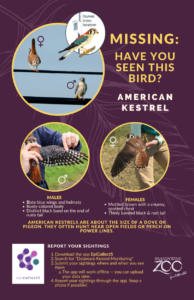
Download our “Have You Seen This Bird” flyer for more details and information on how to identify this little falcon, and how to get in touch with us.
Log sightings of kestrels you see using the information found above.
Banding Kestrels
As an ongoing part of our study, we’ve been putting uniquely numbered aluminum leg bands on both chick and adult kestrels, to help us better learn about this State-Endangered species, but they’re small and nearly impossible to read from afar.
In 2021, our researchers began putting bright yellow leg bands on kestrels. These bright leg bands are easier to see from afar, which means anyone with a pair of good pair of binoculars can report a sighting of one of our study birds to the USGS Bird Banding Lab (BBL), who will report the information to the Zoo. Any time a kestrel is recovered or re-sighted by the public and reported to the BBL it helps contribute to the ongoing research of this program!
COLOR LEG BANDS
Brandywine Zoo researchers are currently using yellow leg bands with a sideways, black, three-digit number on them. These bands were first deployed in the 2021 nesting season and are different from the regular USGS aluminum bands (shown in the section below). The colored leg bands are made of plastic and wrap around the leg 1.5 times to self-secure. Their large scale font is visible from much further away, so you don’t have to physically capture the bird to recover its band number.
How Color Bands Work
Each bird bander is given a unique color band to use, as well as unique color of the font, if numbers or letters are used. The combination of the colors of the band, font, and the unique number are all used to create unique identifiers without running out of number-only or letter-only possible combinations.
Report a Color Band
Report a banded bird by visiting the USGS Bird Banding Lab’s website. It will ask you what type of band you’ve encountered.
- Click “Color Marker Only” and proceed.
- You’ll be asked to enter the type of band. All our birds are currently banded on their RIGHT LEG with a Yellow Marker and the color code is Black. You’ll be asked to enter the numeric code.
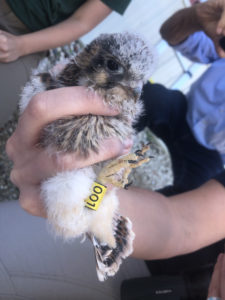
American kestrel chick “001” with one of the Zoo’s unique leg bands.

Standard USGS aluminum leg band. (Photo: J. White)
USGS ALUMINUM LEG BANDS
Ornithologists in the United States are issued uniquely-numbered bands and tags from the US Geological Service (USGS), who keeps track of a massive database of banded birds. For our study, we use a small, aluminum band which goes on the American kestrel’s leg. Putting unique numbers on birds helps researchers like those at the Brandywine Zoo keep track of individuals over their lives and helps us learn about migration (seasonal movement back and forth), dispersal (leaving one area to live permanently in another), longevity and survival, and more!
The numbers on these bands are so small, however, that the bird needs to be physically caught and held to read the number and find out who the bird is. If you ever find a bird with a numbered leg band, wing tag, or neck collar, you can report it (called a Band Encounter) to the USGS Bird Banding Lab’s website.
